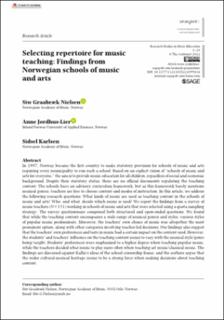| dc.contributor.author | Nielsen, Siw Graabræk | |
| dc.contributor.author | Jordhus-Lier, Anne | |
| dc.contributor.author | Karlsen, Sidsel | |
| dc.date.accessioned | 2022-11-14T12:29:07Z | |
| dc.date.available | 2022-11-14T12:29:07Z | |
| dc.date.created | 2022-06-03T09:14:00Z | |
| dc.date.issued | 2022 | |
| dc.identifier.citation | Research Studies in Music Education. 2022, 1-18. | en_US |
| dc.identifier.issn | 1321-103X | |
| dc.identifier.uri | https://hdl.handle.net/11250/3031700 | |
| dc.description.abstract | In 1997, Norway became the first country to make statutory provision for schools of music and arts requiring every municipality to run such a school. Based on an explicit vision of “schools of music and arts for everyone,” the aim is to provide music education for all children, regardless of social and economic background. Despite their statutory status, there are no official documents regulating the teaching content. The schools have an advisory curriculum framework, but as this framework barely mentions musical genres, teachers are free to choose content and modes of instruction. In this article, we address the following research questions: What kinds of music are used as teaching content in the schools of music and arts? Who, and what, decide which music is used? We report the findings from a survey of music teachers (N=151) working in schools of music and arts that were selected using a quota sampling strategy. The survey questionnaire comprised both structured and open-ended questions. We found that while the teaching content encompasses a wide range of musical genres and styles, various styles of popular music predominate. Moreover, the teachers’ own choice of music was altogether the most prominent option, along with other categories involving teacher-led decisions. Our findings also suggest that the teachers’ own preferences and taste in music had a certain impact on the content used. However, the students’ and teachers’ influence on the teaching content seems to vary with the musical style/genre being taught. Students’ preferences were emphasized to a higher degree when teaching popular music, while the teachers decided what music to play more often when teaching art music/classical music. The findings are discussed against Kallio’s ideas of the school censorship frame, and the authors argue that the wider cultural-musical heritage seems to be a strong force when making decisions about teaching content. | en_US |
| dc.language.iso | eng | en_US |
| dc.rights | Navngivelse-Ikkekommersiell 4.0 Internasjonal | * |
| dc.rights.uri | http://creativecommons.org/licenses/by-nc/4.0/deed.no | * |
| dc.subject | instrumental pedagogy | en_US |
| dc.subject | music education | en_US |
| dc.subject | music teacher education | en_US |
| dc.subject | musical genres and styles | en_US |
| dc.subject | schools of music and arts | en_US |
| dc.subject | socialization | en_US |
| dc.subject | sociology | en_US |
| dc.subject | subjectification | en_US |
| dc.subject | teacher-led musical socialization | en_US |
| dc.subject | teaching content in music schools | en_US |
| dc.title | Selecting repertoire for music teaching: Findings from Norwegian schools of music and arts | en_US |
| dc.title.alternative | Selecting repertoire for music teaching: Findings from Norwegian schools of music and arts | en_US |
| dc.type | Peer reviewed | en_US |
| dc.type | Journal article | en_US |
| dc.description.version | publishedVersion | en_US |
| dc.subject.nsi | VDP::Samfunnsvitenskap: 200 | en_US |
| dc.source.pagenumber | 1-18 | en_US |
| dc.source.journal | Research Studies in Music Education | en_US |
| dc.identifier.doi | 10.1177/1321103X221099436 | |
| dc.identifier.cristin | 2029280 | |
| dc.relation.project | Norges forskningsråd: 274936 | en_US |
| cristin.ispublished | true | |
| cristin.fulltext | original | |
| cristin.qualitycode | 1 | |

